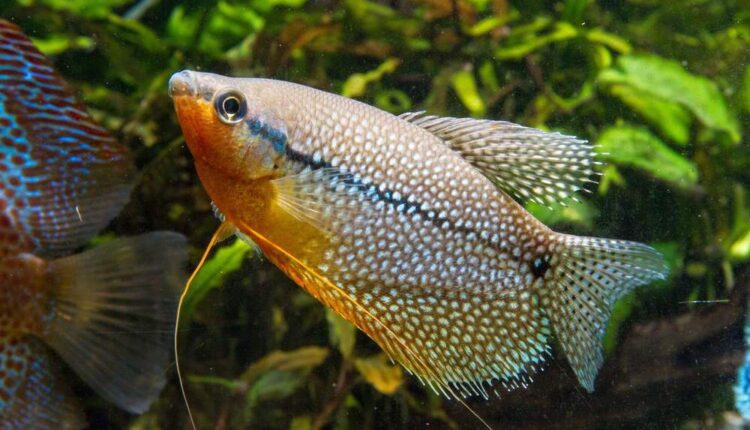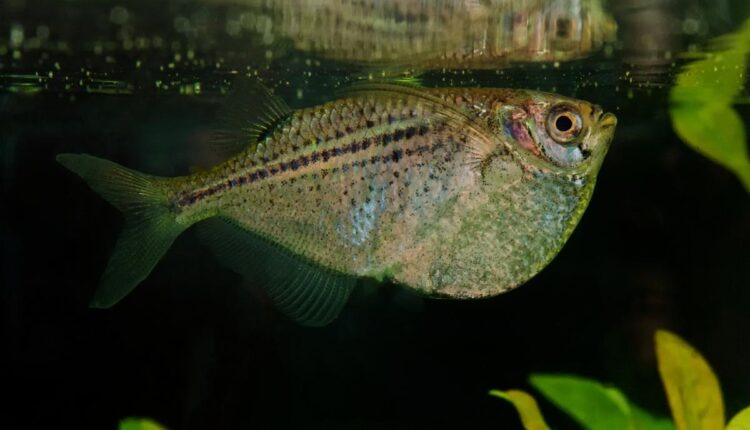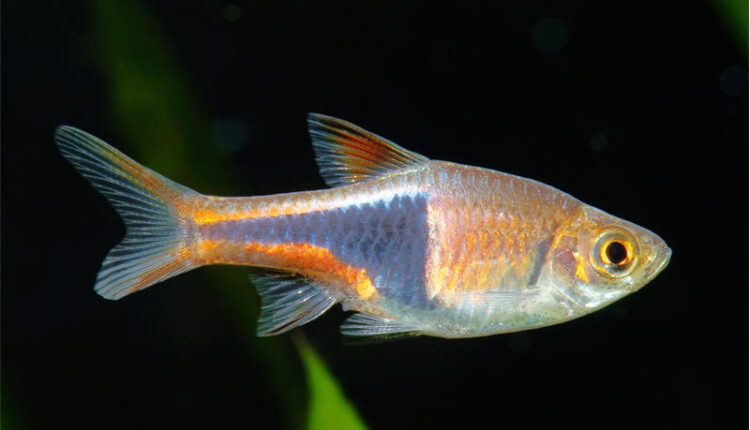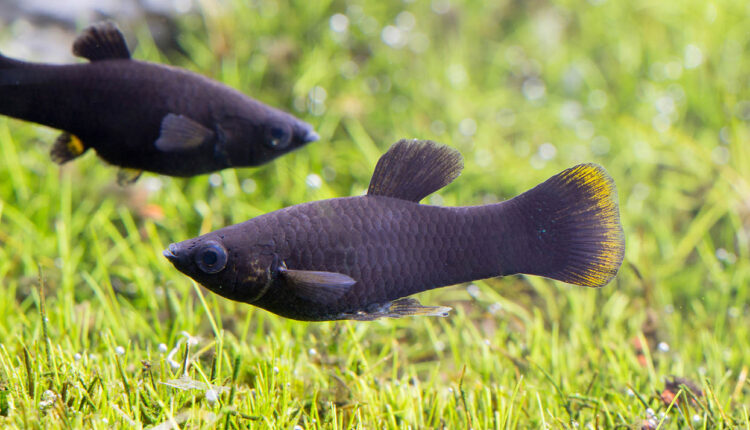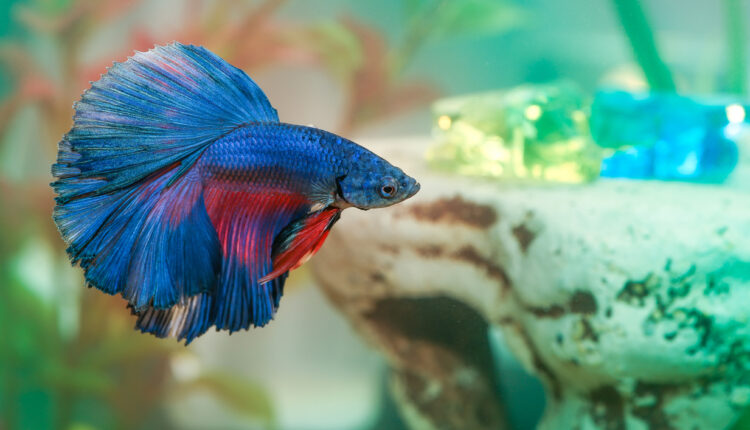18 Popular Rummy Nose Tetra Tank Mates

Many people want to know rummy nose tetra tank mates, but there are not many things rummy nose tetras can go with. It is important to understand that rummy nose tetra does well in a bigger school of individuals and will not do as well when kept with other fish. Among the few rummy nose tetra tank mates, guppies and platys are the best choices for keeping them together without any issues. They also get along well with most species of livebearing fish which makes it easy for you to choose their rummy nose tetra tank mate!
Please note: The author assumes that the reader has an understanding of what rummy nose tetras are and have basic knowledge about caring for an aquarium. If not, read this article.
Rummy Nose Tetra Tank Mates
Rummy Nose Tetras are small schooling fish which means they should be kept in groups of at least six. They will feel stressed if their school is disrupted or broken up – so the best way to keep them happy and healthy is by providing an environment that allows for constant companionship with other rummy nose tetras. If you only have one rummy nose tetra, it’s likely to be lonely (and unhappy) as it cannot establish its own territory within your aquarium! Keeping rummy nose tetras in too small of a group can lead to aggression among themselves over food resources and territories.
Here is the list of 18 fish that can go good with rummy nose tetra in the same tank.
1. Green Neon Tetra
Green neon tetras are non-aggressive and vibrant, making them a good rummy nose tank mate. These fish do well in schools of six or more individuals, so providing your rummy nose tetras with at least that much green neon tetra will help keep them happy!
| Min. Tank Size | 20 Gallons |
| Max. Tank Size | 30 Gallons |
| Temperature | 74-78 degrees Fahrenheit |
| Care Level | Low to medium |
| Diet | Omnivore; Eats most things given to them |
| Adult Size | Up to about two inches long |
| Activeness | Active at dawn and dusk, but can be seen during the day. |
| Behaviour | Behavior is peaceful with other rummy nose tetras. Some introductory aggression may occur when they are introduced for the first time. This will disappear after a few days of being in the same tank together. |
2. Pearl Gourami
The Pearl Gourami can be kept with rummy nose tetras. They are considered to be good fish for rummy nose tetra tank mates because they both have the same basic requirements of clean water and low levels of activity. Another similarity between these two species is that they do not require much space so it would make sense to keep them together in one small aquarium, or at least within close proximity to each other if housed separately due to limited space. This should also apply when keeping any type of gourami with rummy nose tetras as long as there’s sufficient room for all inhabitants’ needs. One downside about this combination is that pearl gouramis will sometimes nip on rummy nose tetras’ fins.
| Min. Tank Size | 20 Gallons |
| Max. Tank Size | 50 Gallons |
| Temperature | 72-82 degrees Fahrenheit |
| Care Level | Moderate |
| Diet | Omnivore |
| Adult Size | Up to an inch |
| Activeness | Medium level swimmer. Used to chase each other and always busy swimming. |
| Behaviour | Peaceful |
3. Corydoras Catfish
Corydoras Catfish are the rummy nose tetra tank mates that can live with rummy nose tetras in a fish tank. Corydoras catfish are bottom-dwelling, peaceful fishes that feed by sifting through sand or mud for food particles from on top of it. It is also called armoured catfish because of its two rows of bony plates running down the middle. Corydoras catfish are small in size and can grow up to four inches long. Corydoras catfish make great rummy nose tetra tank mates because they eat leftover food particles from the surface of rocks or other decorations which reduces any competition between these fish species.
| Min. Tank Size | 20 Gallons |
| Max. Tank Size | 55 Gallons |
| Temperature | 70-80 degrees Fahrenheit |
| Care Level | Easy |
| Diet | Omnivorous |
| Adult Size | Up to four inches |
| Activeness | Moderate |
| Behaviour | Peaceful |
4. Hatchetfish
Hatchetfish can go with rummy nose tetra tank mates. Hatchetfish are small fish in size and is not very aggressive to other fishes but it’s best to keep only one hatchet fish per rummy nose tetra tank because they may be bullied by rummy nose tetras which can grow larger than them. Hatchetfish are small in size and they can be bullied by rummy nose tetras. So, it is best to keep only one hatchet fish per rummy nose tetra tank because rummy nose tetras may grow larger than them.
| Min. Tank Size | 20 Gallons |
| Max. Tank Size | 125 Gallons |
| Temperature | 24-27 degrees Fahrenheit |
| pH Level | Neutral to Slightly Alkaline (Ph of at least seven) |
| Care Level | Low |
| Diet | Omnivorous |
| Adult Size | Up to three inches |
| Activeness | Low |
| Behaviour | Peaceful |
5. Yoyo Loach
Yoyo loach can be kept with rummy nose tetras. But yoyos are territorial and rummy nose tetra may not tolerate them well in the tank as they grow larger than rummy nose tetra. Yoyos should only be added to a rummy nose tetra’s aquarium after an established pecking order has been determined by all of the other fish residing within it first because they will need something to occupy themselves. The maximum number of yoyo loaches that could live together with rummy noses is one per ten gallons of water, so much lower than for most other pairs of peaceful community species that do better when combined at ratios like one small schooling fish per five or six inches.
| Min. Tank Size | 20 Gallons |
| Max. Tank Size | 40 Gallons |
| Temperature | 75-80 degrees Fahrenheit |
| Care Level | Easy |
| Diet | Omnivore/Omnivorous – needs vegetable matter |
| Adult Size | Small |
| Activeness | Moderate |
| Behaviour | Peaceful |
6. Cherry Barb
The Cherry Barb is a live-bearer fish and can be kept in the rummy nose tetra tank mates. It also has different colours which are dark red, orange, pink and yellow. The male will have an extended dorsal fin while females don’t have it at all. They can grow up to three inches long with a life span of two to three years.
Cherry barb is native to the waters where it comes from, which are in Asia and Australia. It lives mostly on the bottom or mid-level depths near weeds, plants and submerged vegetation.
| Min. Tank Size | 20 Gallons |
| Max. Tank Size | 30 Gallons |
| Temperature | 72-78 degrees Fahrenheit |
| Care Level | Moderate |
| Diet | Omnivore |
| Adult Size | Four inches |
| Activeness | Medium |
| Difficulty | Intermediate |
| Behaviour | Very Peaceful |
7. Dwarf Gourami
Dwarf Gourami belongs to the family of Anabantidae. They are a freshwater species and can be found in Asia, Africa, Europe and New Guinea. The most common colour for this fish is orange but they also come in green or gold with some black stripes on their body. Dwarf Gouramis have elongated bodies and can grow up to 12 cm long. The male is more colourful than the female. They are hardy with a peaceful temperament so they’re good tank mates for rummy nose tetra. Due to their body shape, they live on the surface of the water at all times which means that they prefer lots of plants in an aquarium.
| Min. Tank Size | 20 Gallons |
| Max. Tank Size | 50 Gallons |
| Temperature | 64-84 degrees Fahrenheit |
| Care Level | Easy |
| Diet | Omnivore, prefers a variety of animal and plant matter in the diet. Will eat flakes and pellets as well as vegetables. |
| Adult Size | 12 cm long |
| Activeness | Medium |
| Community Behaviour | Peaceful |
8. Harlequin Rasbora
The Harlequin Rasbora is a small schooling fish that can thrive in the rummy nose tetra tank. They are very colourful and active which makes them perfect rummy nose tetra tank mates. The Harlequin Rasbora will not bother rummy nose tetras as they do not share the same water space; rummy nose tetras cannot fit into the Harlequin Rasbora’s smallmouth. The rummy nose tetra may feel threatened by this fast-moving fish but they will not harm rummy noses directly. The rummy nose tetra and harlequin rasbora should be kept in a tank with their own size of space so that neither feels too cramped or crowded while swimming around. It is best to have at least two different species together, as it minimises any aggression from either side and both types are less likely to become territorial if there are other fishes present also housing them within an aquarium setting.
| Min. Tank Size | 20 Gallons |
| Max. Tank Size | 55 Gallons |
| Temperature | 70-82 degrees Fahrenheit |
| Water Type | Soft and slightly acidic water |
| Care Level | Moderate |
| Diet | Omnivore Fish |
| Caring Difficulty | Easy to Moderate |
| Lifespan | Upwards of 12 years |
| Adult Size | Up to about four inches in length |
| Activeness | Moderate |
| Behaviour | Peaceful |
9. Chili Rasbora
The Rummy nose tetras will not be too bothered by the Chilli rasbora. They can be kept together in a tank, but if there are more than one rummy nose tetra then it is best to have two rummy nose tetras per five gallons of water space and one rummy for every ten gallons of water space. The rummy does well with other types of fish that also enjoy living near plants such as kuhli loaches or baby shrimp so these combinations may work especially when care has been taken to give each animal enough room in the aquarium.
| Min. Tank Size | 40 Gallons |
| Max. Tank Size | 90 Gallons |
| Temperature | 72-81 degrees Fahrenheit |
| pH Level | Slightly acidic, best kept between a pH of about six and eight. |
| Care Level | Easy |
| Diet | Omnivore |
| Adult Size | Up to two inches |
| Activeness | Low |
| Behaviour | Aggressive |
10. Zebra Danios
Zebra Danios are a very popular rummy nose tetra tank mate as they swim in groups and will not eat rummy nose tetras. They also grow to be only about an inch long, so they make for good swimming companions without taking up too much space.
Do NOT keep with rummy nose tetra if you don’t want them eaten! If the zebra danios are kept away from the water’s surface then it is said that rummy noses may leave them alone but zebra danios cannot stay out of the way forever and eventually one will get close enough to provoke a bite or two from their fishy friends. These bites could lead to illness because rummys’ mouths have been known to harbor diseases.
| Min. Tank Size | 10 Gallons |
| Max. Tank Size | 30 Gallons |
| Temperature | 65-78 degrees Fahrenheit |
| pH Level | Acidic to close to neutral (pH) |
| Care Level | Medium |
| Diet | Omnivorous |
| Adult Size | Up to .75 inches |
| Activeness | Low |
| Behaviour | Peaceful |
11. Mollies
Mollies are another fish that rummy noses will not eat. This is because mollies, which can grow up to six inches in length, don’t swim near the surface and rummy nose tetras prefer their food closer to the water’s edge.
Mollies may also get bitten by rummys but it doesn’t happen as often so they’re a little safer than zebra danios.
Mollies can also be kept with rummy nose tetras since they don’t eat the same type of food and because both rummys and mollies are schooling fish.
Mollys make great tank mates for rummy noses, but you should keep in mind that they’re a lot slower than rummys so this may not work if your goal is to have an active community aquarium.
| Min. Tank Size | 20 Gallons |
| Max. Tank Size | 140 Gallons |
| Temperature | 72 degrees Fahrenheit |
| pH Level | Around a neutral value of between six and eight; Soft to moderately hard water is best. |
| Care Level | Moderate |
| Diet | Carnivore |
| Adult Size | Up to two inches |
| Lifespan | Up to five years |
| Activeness | Moderate |
| Behaviour | Peaceful |
12. Celestial Pearl Danio
A Rummy nose tetra tank mate which is not too big and fast. It’s a schooling fish that can be kept in the same aquarium as rummy nose tetras.
Celestial Pearl Danio has smaller size than rummy nose tetra and it is more suited for timid people who doesn’t want to deal with large number of fishes. Because they are small, one celestial pearl danio can be added into an empty rummy nose tetra tank without messing up water chemistry or overcrowding them. These danios have beautiful colors from golds to reds so these make good additions on top of the tank or against the back walls of a background setup where light won’t get through often enough for other bottom dwellers to grow.
| Min. Tank Size | 20 Gallons |
| Max. Tank Size | 50 Gallons |
| Temperature | 72-82 degrees Fahrenheit |
| pH Level | Neutral |
| Care Level | Difficult |
| Diet | Omnivore |
| Adult Size | Less than an inch |
| Behaviour | Peaceful, Active, Aggressive with Tank Mates |
13. Snails
Rummy nose tetra tank mates should not include Snails. Snails are often too slow for rummy nose tets because the little fish will eat them before they can escape or hide in a hole. The rummy noses may also pick at their shells, and potentially ingest bits of it as they do so, which is bad for both parties involved. It’s advised to keep snails with other types of aquarium dwellers instead that don’t have fins like shrimp or even crayfish; this way if rummy’s nip on their shells, there isn’t any risk of injuring themselves internally by eating parts off them.
Snails can be a good tank mate for rummy nose tetras, just not with the rummys. They are slow enough to give rummy noses time to get away and they don’t have fins so there is no risk of getting injured by eating parts off them as in the case of shrimp or crayfish.
| Min. Tank Size | 30 Gallons |
| Max. Tank Size | 120 Gallons |
| Temperature | 72-78 degrees Fahrenheit |
| Care Level | Easy |
| Diet | Omnivore |
| Adult Size | Up to a few inches |
| Activity Level | Low |
| Behaviour | Very timid by nature but they’ll feed off of the surface with other fish |
14. Shrimps
Shrimps are one of the rummy nose tetra tank mates that can live in the same aquarium. They have a lot of benefits like they eat leftover food, remove algae from plants and tanks walls, and provide aeration to rummy nose tetras. Shrimp also feeds on any uneaten fish food which may be floating around so less waste is going into the water column or substrate below your tank. One thing you should keep an eye out for when keeping shrimps with rummy nose tetras is disease transfer because shrimp carry diseases that rummy noseds do not know how to fight off.
| Min. Tank Size | 30 Gallons |
| Max. Tank Size | 200 Gallons |
| Temperature | 73-82 degrees Fahrenheit |
| Care Level | Beginner |
| Diet | Carnivore |
| Adult Size | Up to about two inches |
| Activity Level | Low to Moderate |
| Lifespan | Up to five years in the wild |
| Behaviour | Peaceful |
15. Diamond Tetra
Diamond tetra is a very popular rummy nose tetra tank mate. They are one of the best rummy nose tetra tank mates because they have similar water temperature requirements and preferences, as well as being peaceful and easy to keep. However, rummy noses can be aggressive towards other fishes if there are too many in the same space so it’s important not to overcrowd the tank with these fish or else your rummys may bully their new friends out of territory.
| Min. Tank Size | 20 Gallons |
| Max. Tank Size | 55 Gallons |
| Temperature | 68-76 degrees Fahrenheit |
| pH Level | Neutral to Slightly Alkaline |
| Care Level | Easy |
| Diet | Omnivore, But Mostly Herbivore |
| Adult Size | Up to an Inch |
| Activeness | Calm |
| Behaviour | Peaceful |
16. Black Neon Tetra
Black neon tetra is a schooling fish that should be kept in groups of at least six. They live for up to ten years and are relatively peaceful towards other fishes. Black neons are best kept with rummy nose tetras because they have similar requirements as rummy noses do, such as their water temperature preference (72-77F). However, black neons can also get stressed if tank mates are too aggressive or territorial around them, so it’s important to only keep one species from this genus together.
The rummy nose tetra usually turns out well when paired with any calm fish but there could be some exceptions due to aggression between the two types of species involved. For instance, angelfish or cardinal tetras are best kept with rummy nose tetras that are on the small side.
| Min. Tank Size | 20 Gallons |
| Max. Tank Size | 30 Gallons |
| Temperature | 73-77 degrees Fahrenheit |
| Care Level | Easy |
| Diet | Omnivore |
| Lifespan | Up to five years in the wild |
| Adult Size | Up to an Inch |
| Activeness | Peaceful |
| Behaviour | Social |
17. Cardinal Tetra
This is a common fish which rummy nose tetra tank mates can go with. The rummy nose tetras are not territorial and they will be fine in the same aquarium as long as their water conditions, temperature, pH levels etc. are all fine.
The rummy nose tetra tank mates can be kept in a community aquarium with small fish like the cardinal tetra, neon tetras and so on.
Cardinal Tetras are very easy to care for as long as their water conditions are maintained properly which rummy nose tetras will do just fine at maintaining this.
This means that they need plenty of fresh water regularly changed out during the day (usually about 30% per week) and should not have any ammonia or nitrites detected in them when tested using your test kit supplied by your pet store). – For the most part these fishes will live happily together except if you’re trying to keep more than six rummys nose tetras in one tank together then it is best to avoid keeping any other small fish in the tank with rummy nose tetras as they will become stressed and can eventually die.
| Min. Tank Size | 30 Gallons |
| Max. Tank Size | 120 Gallons |
| Temperature | 65-80 degrees Fahrenheit |
| pH Level | Neutral to Slightly Alkaline |
| Care Level | Easy |
| Diet | Omnivore |
| Lifespan | Up to 12 years |
| Adult Size | 15-18 inches |
| Activeness | Peaceful |
| Behaviour | They are peaceful and will avoid any conflict with other fish |
18. Bettas
Bettas are not rummy nose tetra tank mates because they cannot coexist in the same tank (too many aggressive behaviours). Do not keep betta with rummy noses.
Betta can be kept with other fishes like neon tetras, swordtails and platys. Bettas are not rummy nose tank mates because they cannot coexist in the same tank (too many aggressive behaviours). Do not keep betta with rummy noses.
Alert: We included this in our list as last to remind you that you also need to know about some other fishes which are NOT safe for rummy nose tetra in the same tank. In other section of this article we have listed some of the fishes you need to avoid keeping with rummy nose tetra.
| Min. Tank Size | 20 Gallons |
| Max. Tank Size | 40 Gallons |
| Temperature | 78-86 degrees Fahrenheit |
| Care Level | Easy |
| Diet | Omnivore |
| Lifespan | Three to five years |
| Adult Size | Up to two inches (cm) in length |
| Activeness | Very active |
| Behaviour | Peaceful |


